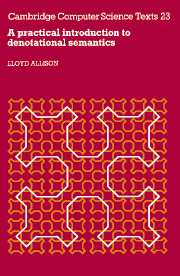Book contents
Summary
This is an introductory textbook on denotational semantics intended for interested computer scientists, for undergraduates towards the end of their course and for postgraduates beginning theirs. The material has been used in a final-year undergraduate course at the University of Western Australia for some years. The objective is to introduce readers to the range of material, both mathematical and practical, in the subject so that they may carry out simple applications and understand more advanced material.
The mathematical foundations of denotational semantics are covered in sufficient detail to illustrate the fundamental problems in semantic theory that were solved by Scott. The section is self-contained but a background including a computer-science or mathematics course on discrete structures or algebra would be helpful. It can be skipped on a first reading or omitted by a reader prepared to take the foundations on trust.
The remainder of the book covers the use of denotational semantics to describe sequential programming languages. Knowledge of at least one high-level programming language, such as Ada, Algol, C, Modula, Pascal or PL 1, is essential. It is an advantage to be aware of the general features of several languages so as to realize the variety available. Familiarity with compilation, interpretation and functional programming is also a help.
A great deal of emphasis is placed on practical work. The usual notation of denotational semantics is akin to a powerful functional programming language.
Information
- Type
- Chapter
- Information
- A Practical Introduction to Denotational Semantics , pp. viii - ixPublisher: Cambridge University PressPrint publication year: 1987
